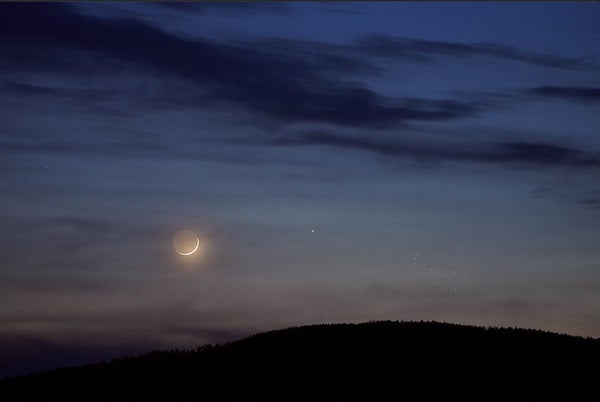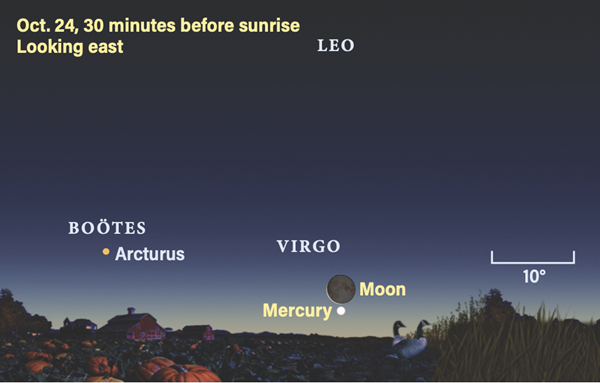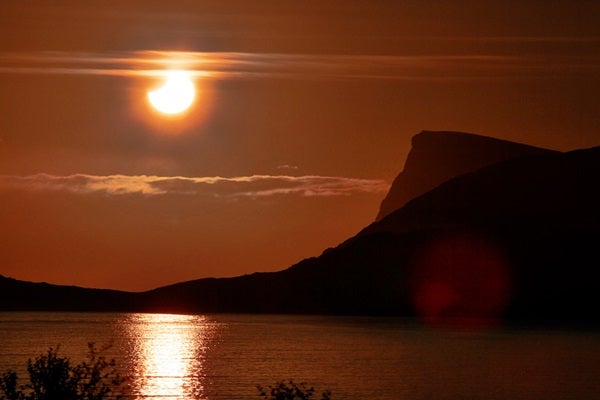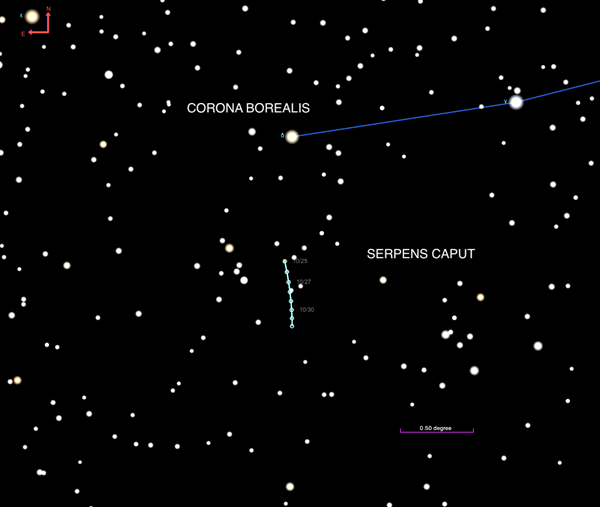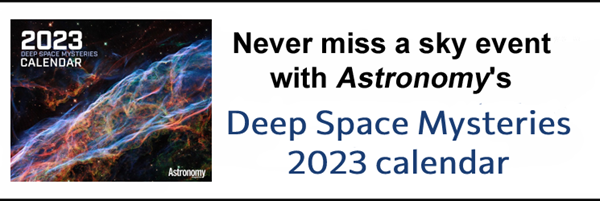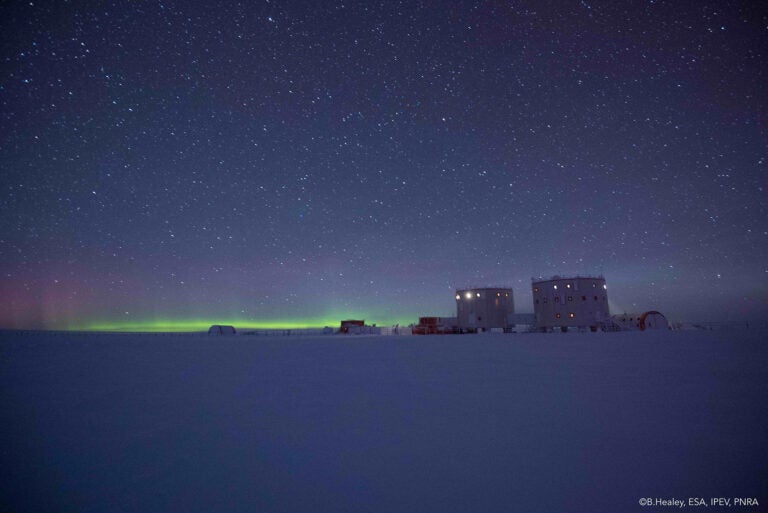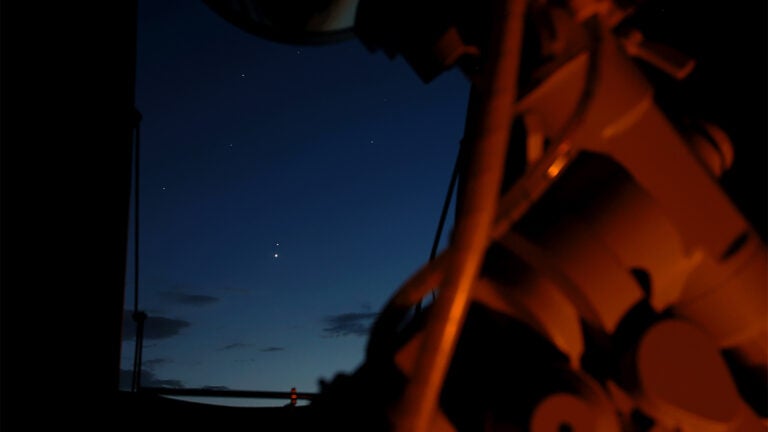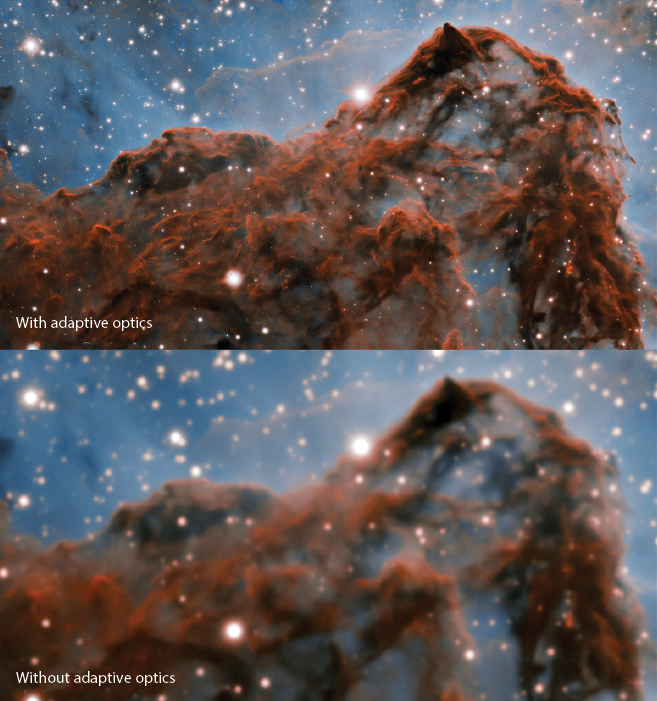Friday, October 21
The Orionid meteor shower peaks today; early risers with clear skies can expect to see some 15 to 18 meteors per hour in the hours leading up to sunrise. The shower’s radiant sits near Betelgeuse, the bright red star that serves as Orion’s right shoulder. (The Hunter is typically drawn facing the observer, so the star appears on the left side of the figure as seen on the sky). Around 5 A.M. local time, this point is some 65° high in the southern sky. For the best chance of spotting long meteor trains, however, look some 45° to 90° away from this point.
If you missed the show this morning, don’t worry — the next few mornings should hold increased meteor rates as well.
As darkness falls this evening, Cassiopeia the Queen and her daughter, Andromeda the Princess, are rising in the northeast. Cassiopeia is often recognizable by the W-shaped pattern of her stars; the letter appears facing right-side up tonight after sunset.
The Queen is home to several deep-sky objects, including the rich open cluster NGC 7789, sometimes called the White Rose Cluster. Spanning about 16′ and glowing at magnitude 6.7, this is a stunning object in binoculars or a small telescope. You’ll find it just 3° southwest of magnitude 2.3 Caph, the constellation’s beta star. If your sky is clear, take some time to admire this cluster. Keen-eyed observers may notice alternating loops of stars and darkness that give the appearance of a rose viewed from above — hence, NGC 7789’s common name.
Sunrise: 7:17 A.M.
Sunset: 6:11 P.M.
Moonrise: 3:03 A.M.
Moonset: 4:44 P.M.
Moon Phase: Waning crescent (15%)
*Times for sunrise, sunset, moonrise, and moonset are given in local time from 40° N 90° W. The Moon’s illumination is given at 12 P.M. local time from the same location.
Saturday, October 22
Venus reaches superior conjunction with the Sun at 5 P.M. EDT. Currently invisible, Earth’s sister planet will return to the skies as an evening star later this year.
Jupiter’s four Galilean moons have been busy this month and tonight, the spotlight is on Io and Europa. The latter recently stolen news headlines when NASA’s Juno probe made a close flyby of the icy world. Turn your telescope on Jupiter late this evening — you’ll find the gas giant about 40° high in the southeast around 10:00 P.M. EDT. At that time, two moons sit to its east and two to its west: Callisto is farthest east, with Europa closer to the planet; on the west, Ganymede is closest, with Io a little farther out. Jupiter’s stunning Great Red Spot should also be on display, located roughly in the center of the planet around this time.
Keep a close watch on things as the evening progresses. Around 11:30 P.M. EDT, you’ll see Ganymede disappear behind the planet’s northwestern limb. Less than two hours later — note that this is after midnight in the Eastern and Central time zones but still on the 22nd for those farther west — Europa starts a transit at 1:18 A.M. EDT (10:18 P.M. PDT on the 22nd), moving onto the planet’s disk from the east. Io follows in Ganymede’s footsteps, disappearing behind the western limb at 2:11 A.M. EDT on the 23rd (11 P.M. PDT on the 22nd). Finally, Europa’s slowpoke shadow follows it onto the disk, trailing behind the moon across the cloud tops beginning at 2:36 A.M. EDT on the 23rd (11:36 P.M. PDT on the 22nd).
Sunrise: 7:18 A.M.
Sunset: 6:10 P.M.
Moonrise: 4:07 A.M.
Moonset: 5:07 P.M.
Moon Phase: Waning crescent (9%)
Sunday, October 23
Saturn is stationary against the background stars of Capricornus at 5 A.M. EDT, finally ending its retrograde loop across the sky. The planet is visible in the evening, about 30° high in the south an hour after sunset. Saturn now glows at magnitude 0.5 and sits close to 4th-magnitude Iota (ι) Capricorni, just 35′ to the star’s northeast (upper left).
Through a telescope, Saturn’s disk stretches 17″ across, while its rings are 40″ from end to end. Several of its moons are visible, including magnitude 8.5 Titan, which sits 50″ to the planet’s northwest (upper right). Notable, too, are 10th-magnitude Rhea, Dione, and Tethys: Rhea is about 1′ due west of Saturn, while Dione is 24″ to its northeast and Tethys is 40″ east-southeast.
Also visible is 10th-magnitude Iapetus, whose brighter hemisphere is now facing Earth. The smaller moon is located farther than the other visible satellites and is nearly 8′ to the planet’s west-southwest. It will reach greatest western elongation tomorrow, when it sits due west of the planet.
Sunrise: 7:19 A.M.
Sunset: 6:09 P.M.
Moonrise: 5:14 A.M.
Moonset: 5:30 P.M.
Moon Phase: Waning crescent (4%)
Monday, October 24
Mercury is now a challenge to spot in the mornings, but today in particular, it’s worth trying. Half an hour before sunrise, the solar system’s smallest planet is some 4° high in the east. Glowing a bright magnitude –1.1, Mercury hangs 1° directly below (southeast of) the thinnest sliver of Moon, which is just one day prior to New. Pull out binoculars or even use your finder scope to enjoy the pair, but take care to put away any visual aids several minutes before the Sun is due to rise (which may differ from the time given below, depending on your location).
These two have more in store for us today, too: Around 10 A.M. EDT, U.S. observers will see the Moon occult Mercury. But note this is a tricky observation not for first timers — the Sun is nearby (10° away) so you’ll need to take significant precautions. Never randomly scan the daytime sky for any target. Only experienced observers who know how to protect their eyes and use their tracking go-to scope during daylight hours should attempt to view this event.
Sunrise: 7:20 A.M.
Sunset: 6:07 P.M.
Moonrise: 6:19 A.M.
Moonset: 5:54 P.M.
Moon Phase: Waning crescent (1%)
Tuesday, October 25
The Moon passed in front of Mercury yesterday. Today, it reaches New phase at 6:49 A.M. EDT and, several hours later, crosses in front of the Sun in a partial solar eclipse. This event is visible from most of Europe, northeastern Africa, southwestern Asia, the Middle East, India, and parts of Russia. Partial eclipses occur when the Moon slides too high or low to cover the entire disk of the Sun. This also means that visual protection must be worn throughout the eclipse, even at maximum, unlike total eclipses where you can remove your eyewear for the brief moments of totality. It is never safe to look without a solar filter at the unobscured Sun at any point during a partial eclipse.
The time of the eclipse and the amount of the Sun the Moon will cover depend on your location — for example, in London, our satellite will cover 26 percent of the Sun’s diameter (a maximum obscuration of 15 percent) as the Moon passes across the Sun’s face from 10:08 A.M. to 11:51 A.M. local time. Many other locations will see much more of the Sun covered and a longer duration for the eclipse. There are several online resources available for those curious about the eclipse in their location.
Sunrise: 7:22 A.M.
Sunset: 6:06 P.M.
Moonrise: 7:29 A.M.
Moonset: 6:20 P.M.
Moon Phase: New
Wednesday, October 26
Mars has swollen from 12″ to 15″ in apparent diameter this month as it nears its end-of-year opposition. That means now is the time to practice sighting and capturing video images of the Red Planet’s surface features as they grow more visible with time.
Currently in Taurus, Mars is magnitude –1.1, far outshining the luminary red giant Aldebaran at magnitude 0.1. The Red Planet now sits between the endpoints of Taurus’ horns: 3rd-magnitude Alheka and 2nd-magnitude Elnath. It’s been moving east against the background stars each night but by the end of the month, it will have halted that motion and started moving back toward the Bull’s face to meet up with Aldebaran and the Hyades.
Mars rotates slightly slower than Earth, which means that from our point of view, features appear to slide backwards from night to night. In the few hours before and after local midnight, the dark blotch of Syrtis Major and the brighter Hellas basin are visible on the Earth-facing side for observers in the Midwest. Observers in other locations may see these features slightly earlier or later. See if you can also spot the long, dark line of Utopia Planitia stretching out in the planet’s northern hemisphere.
Sunrise: 7:23 A.M.
Sunset: 6:05 P.M.
Moonrise: 8:42 A.M.
Moonset: 6:52 P.M.
Moon Phase: Waxing crescent (2%)
Thursday, October 27
Comet C/2022 E3 (ZTF) is preparing to (hopefully) stun us early next year, when it is estimated to reach 6th magnitude or brighter. For now, it’s still 11th magnitude as it skims slowly away from Corona Borealis, moving through Serpens Caput. Tonight, you can find it shortly after sunset by dropping just under 1° south of 5th-magnitude Delta (δ) Coronae Borealis in the west. The region sets around 10 P.M. local time, though you’ll likely lose any good views of the comet about an hour before that, as it sinks into the turbulent air near the horizon.
Although ZTF will swell in size and brightness over the coming months, for now, it’s best seen with an 8-inch or larger scope under dark skies. It will look like a slightly fuzzy-edged puffball of soft, diffuse light, compared with the sharp pinpricks of stars shining around it. Comets warm as they near the Sun, which sublimates gases off the surface to build up a bigger, fuzzier coma around the nucleus and a long dust tail stretching behind it. For now, ZTF is still nearly 155 million miles (250 million kilometers) from the Sun; it will close to 100 million miles (166 million km) by perihelion in early January next year.
Sunrise: 7:24 A.M.
Sunset: 6:04 P.M.
Moonrise: 9:58 A.M.
Moonset: 7:31 P.M.
Moon Phase: Waxing crescent (Waxing crescent (6%)
Friday, October 28
Earlier in the week, we caught the show as dust particles left behind by Comet 1P/Halley created the stunning Orionid meteors. This morning before dawn, you can catch a different kind of light created by the same material: zodiacal light.
This gentle glow comes not from dust particles burning up in Earth’s atmosphere, but from sunlight scattering off dusty debris left by comets as it orbits in the plane of the solar system. With no Moon to interfere, you’ll still want to choose a dark viewing site in the hours before dawn. Look for a cone-shaped glow thrusting upward from the eastern horizon and climbing into the sky though Leo, Cancer, and Gemini as it narrows. At this time of year, because the zodiacal light is visible in the morning before sunrise, it is often called the false dawn.
As a bonus, you may yet be rewarded with a few sporadic bright meteors as the Orionids continue to wind down from the peak last week.
Sunrise: 7:25 A.M.
Sunset: 6:02 P.M.
Moonrise: 11:13 A.M.
Moonset: 8:18 P.M.
Moon Phase: Waxing crescent (13%)

